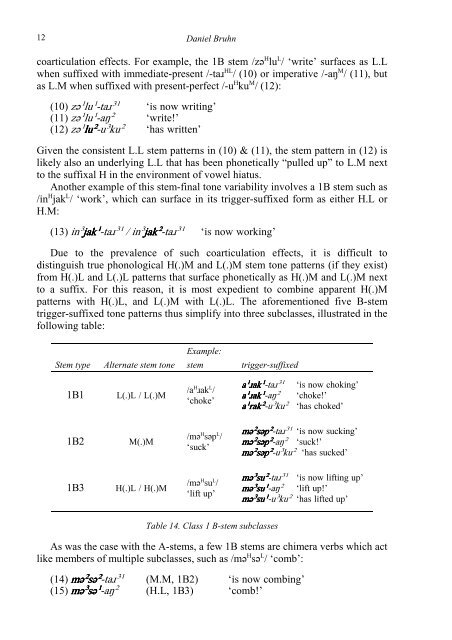A TONAL TAXONOMY OF CHUNGLI AO VERBS Daniel Bruhn ...
A TONAL TAXONOMY OF CHUNGLI AO VERBS Daniel Bruhn ...
A TONAL TAXONOMY OF CHUNGLI AO VERBS Daniel Bruhn ...
Create successful ePaper yourself
Turn your PDF publications into a flip-book with our unique Google optimized e-Paper software.
12<br />
<strong>Daniel</strong> <strong>Bruhn</strong><br />
coarticulation effects. For example, the 1B stem /zə H lu L / ‘write’ surfaces as L.L<br />
when suffixed with immediate-present /-taɹ HL / (10) or imperative /-aŋ M / (11), but<br />
as L.M when suffixed with present-perfect /-u H ku M / (12):<br />
(10) zə¹lu¹-taɹ³¹ ‘is now writing’<br />
(11) zə¹lu¹-aŋ² ‘write!’<br />
(12) zə¹lu² lu²-u³ku² lu² lu² ‘has written’<br />
Given the consistent L.L stem patterns in (10) & (11), the stem pattern in (12) is<br />
likely also an underlying L.L that has been phonetically “pulled up” to L.M next<br />
to the suffixal H in the environment of vowel hiatus.<br />
Another example of this stem-final tone variability involves a 1B stem such as<br />
/in H jak L / ‘work’, which can surface in its trigger-suffixed form as either H.L or<br />
H.M:<br />
(13) in³jak¹ jak¹-taɹ³¹ jak¹ jak¹ / in³jak² jak²-taɹ³¹ jak² jak² ‘is now working’<br />
Due to the prevalence of such coarticulation effects, it is difficult to<br />
distinguish true phonological H(.)M and L(.)M stem tone patterns (if they exist)<br />
from H(.)L and L(.)L patterns that surface phonetically as H(.)M and L(.)M next<br />
to a suffix. For this reason, it is most expedient to combine apparent H(.)M<br />
patterns with H(.)L, and L(.)M with L(.)L. The aforementioned five B-stem<br />
trigger-suffixed tone patterns thus simplify into three subclasses, illustrated in the<br />
following table:<br />
Example:<br />
Stem type Alternate stem tone stem trigger-suffixed<br />
1B1 L(.)L / L(.)M<br />
1B2 M(.)M<br />
1B3 H(.)L / H(.)M<br />
/a H ɹak L /<br />
‘choke’<br />
/mə H səp L /<br />
‘suck’<br />
/mə H su L /<br />
‘lift up’<br />
Table 14. Class 1 B-stem subclasses<br />
a¹ɹɹɹɹak¹ a¹ a¹ a¹ ak¹-taɹ³¹ ak¹ ak¹ ‘is now choking’<br />
a¹ɹɹɹɹak¹ a¹ a¹ a¹ ak¹-aŋ² ak¹ ak¹ ‘choke!’<br />
a¹rak a¹rak²²²²-u³ku² a¹rak a¹rak ‘has choked’<br />
mmmməəəə²²²²ssssəəəəp² p²-taɹ³¹ p² p² ‘is now sucking’<br />
mmmməəəə²s ²səəəəp² ²s ²s p²-aŋ² p² p² ‘suck!’<br />
mmmməəəə²s ²səəəəp² ²s ²s p²-u³ku² p² p² ‘has sucked’<br />
mmmməəəə³su² ³su² ³su²-taɹ³¹ ³su² ‘is now lifting up’<br />
mmmməəəə³su¹ ³su¹ ³su¹-aŋ² ³su¹ ‘lift up!’<br />
mmmməəəə³su¹ ³su¹ ³su¹-u³ku² ³su¹ ‘has lifted up’<br />
As was the case with the A-stems, a few 1B stems are chimera verbs which act<br />
like members of multiple subclasses, such as /mə H sə L / ‘comb’:<br />
(14) mmmməəəə²s ²səəəə²²²²-taɹ³¹ ²s ²s<br />
(M.M, 1B2) ‘is now combing’<br />
(15) mmmməəəə³³³³ssssəəəə¹¹¹¹-aŋ² (H.L, 1B3) ‘comb!’

















